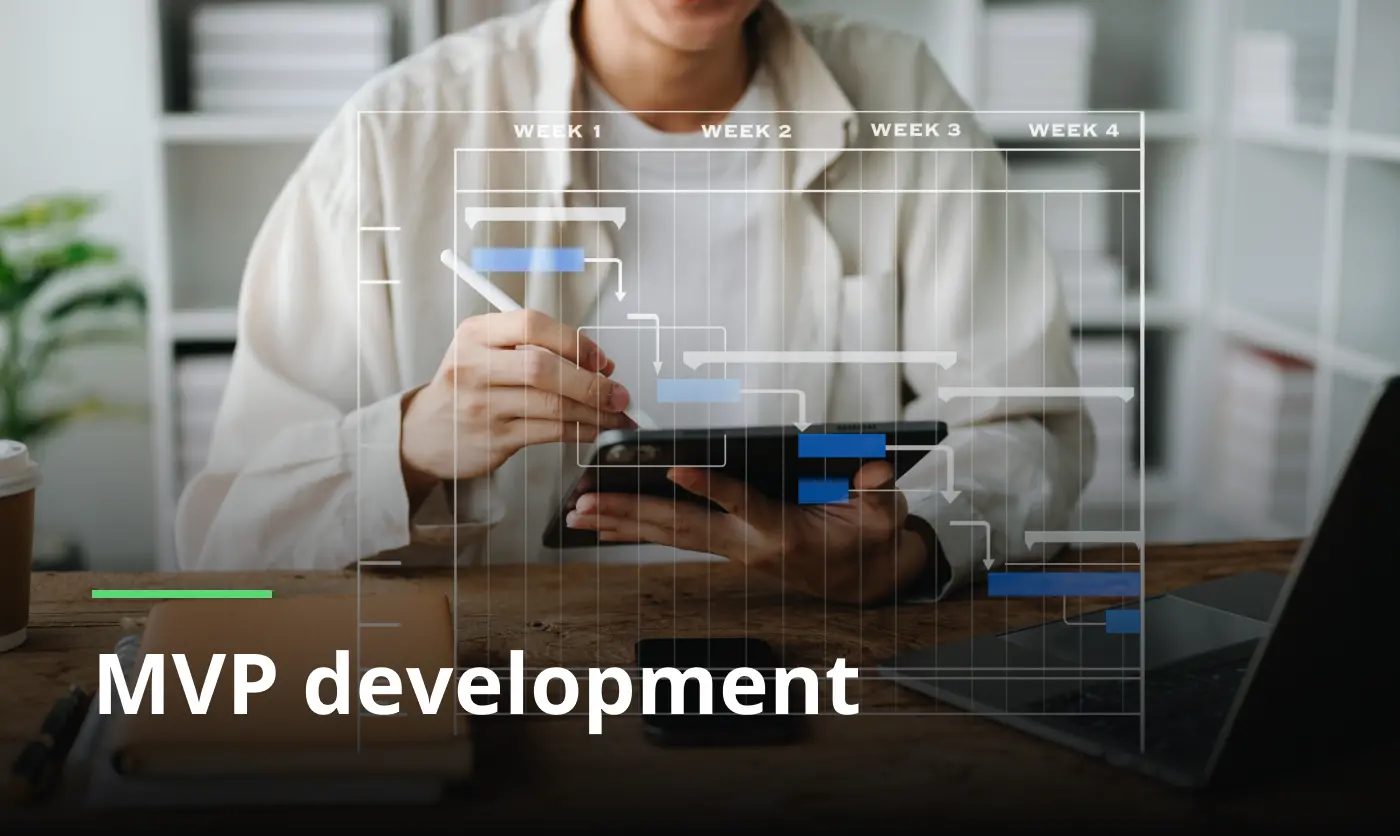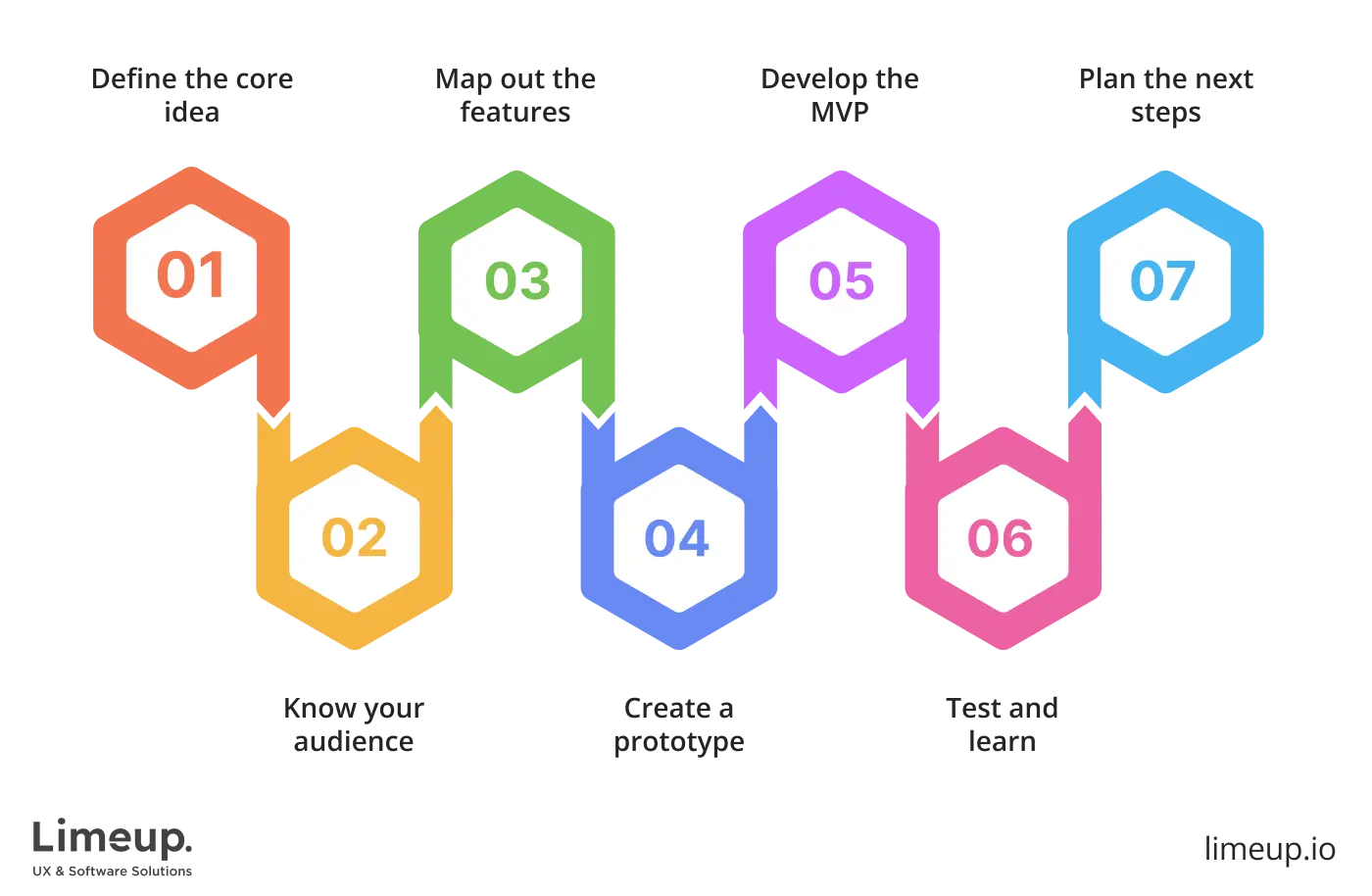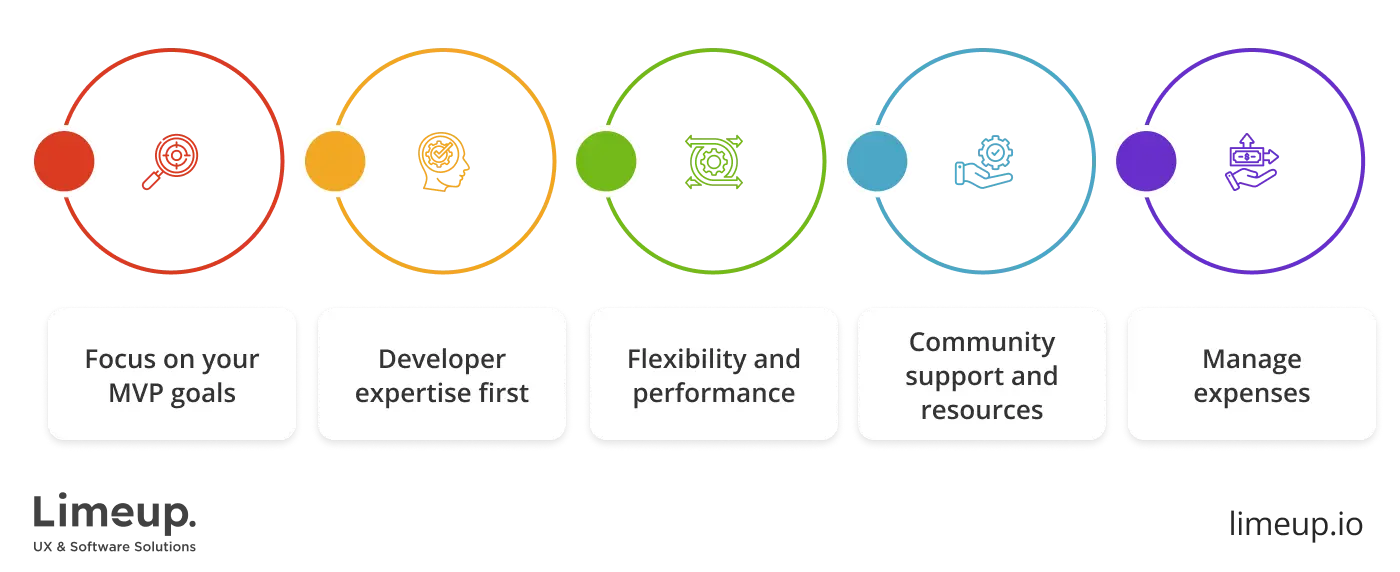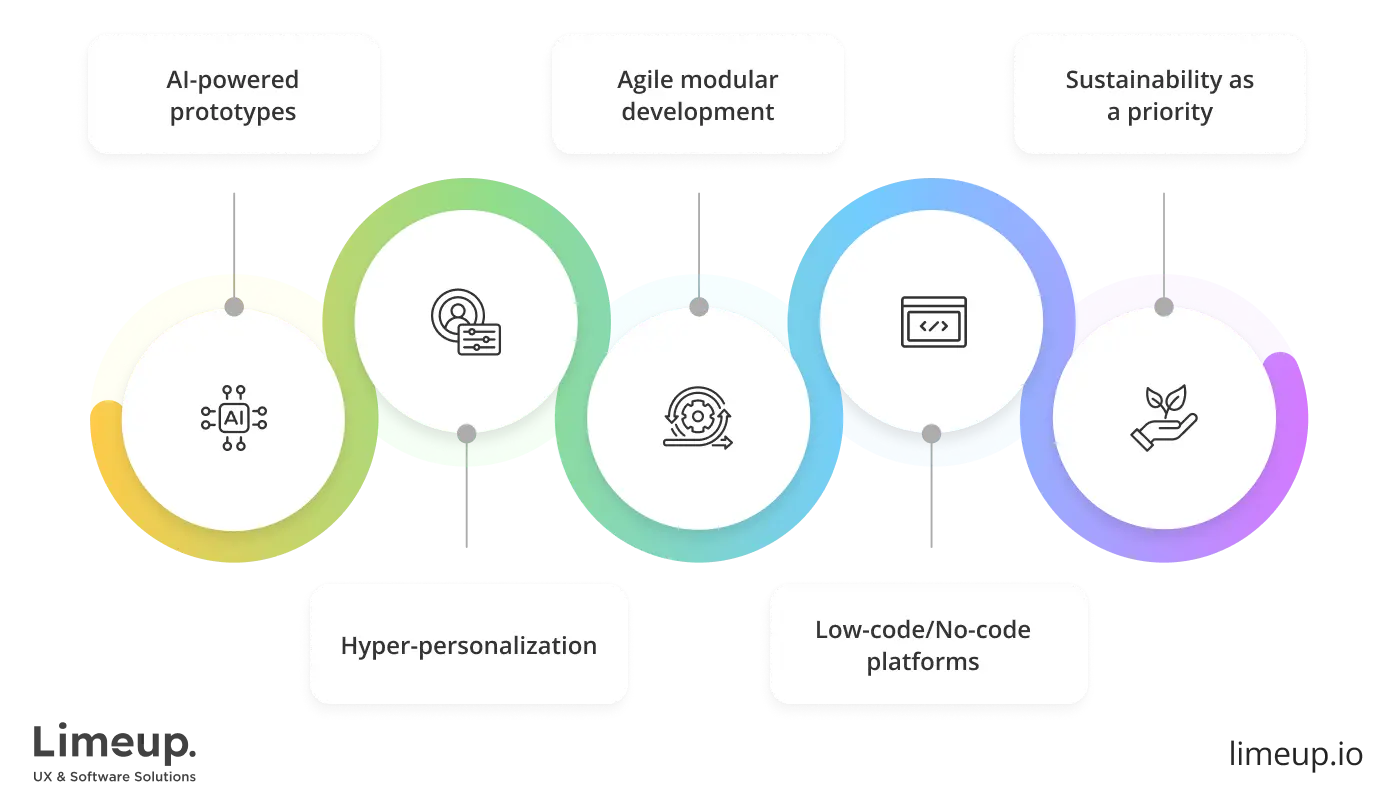MVP Development: Full Overview

The first move in mastering how to build an MVP is charting a clear outline that directs the entire development strategy. From zeroing in on the essentials to choosing the optimal tech stack, the goal is to develop a minimum viable version is all about honing in on what truly counts. You can introduce your product to dip your toes into the market waters and adapt as feedback guides your next move.
MVP development is a robust strategy for entrepreneurs looking to bring their product ideas to fruition with efficiency. A minimum viable product (MVP) allows you to test your concept with minimal investment, offering a sneak peek of what’s to come while keeping costs under control and staying in the lead.
Building an MVP centers on quick action, minimalism, and adaptability. A brief synopsis of this approach underscores its dedication to tackling core user needs, testing the product and refining it based on users’ feedback. This way, you avoid going down the wrong path, saving efforts and resources while refining your ideas.
What is MVP development?
Minimum Viable Product (MVP) production is a development strategy with the aim of creating the simplest version of a product that has just a small number of functions to meet the needs of early adopters and gather feedback. It’s akin to an idea skeleton, to be sure it can exist early and you can add the muscles and bling later. It’s not about shortcuts, it’s about testing that deep before diving in head first.
The essence of MVP design lies in its simplicity and purpose. The pitfall of over-stuffing the initial product with features that might not resonate with people would be avoided by not including every functionality. With this approach, you validate your concept with end users in real-world conditions so you aren’t wasting your time with the wrong tree regarding what your audience is interested in.
Development of the MVP is one of the most cost-efficient things you can do. Launching a fully-fledged product can be a shot in the dark, potentially burning through resources without guaranteeing success. Early adopters give you extremely valuable feedback, help you perfect your offering and show you where to focus your efforts.
The MVP approach also fosters agility. When you’re in the fast-paced digital world, being able to jump in and out of any trends without breaking a sweat is crucial. Mastering how to build a minimum viable product allows businesses to pivot their tactic and add components based on real-time feedback. It’s like having a GPS for your product roadmap — knowing where you ultimately want to go and avoiding distractions along the way.
In essence, early-stage development is a smart, strategic approach for entrepreneurs and companies looking to test ideas, draw in new users, and set the stage for future growth. It allows you to learn, adapt, and evolve without breaking the bank.
MVP creation might also lessen the chance of long-term failure — 80% of apps have a survival rate of less than a year. So, if you’re considering bringing an idea to life, starting with an MVP might just be your ace in the hole.
How to build an MVP instructions
The process of launching MVP in software development is similar to creating the foundation of a house — you need the barebones to survive but you can leave the fancy embellishments for later. It is a process of making a solution that serves the core value of the users while making it lean and efficient. Here’s how to handle this task step by step.

- Define the core idea. Find out what your product will solve and the major elements that will be required for its implementation. Don’t bite more than you can chew by seeking out the ‘must-haves’ rather than the ‘nice to haves’. This is the stage where MVP developers help to distill your idea into its purest form, like boiling down a complex concept into a single sentence.
- Know your audience. How can you hit the bullseye if you don’t know what the goal is? Review your target audience very well — in terms of your understanding of their pain points, preferences, and behavior. With this insight, you’ll be able to produce an MVP that users will identify with and that has a better chance of standing out in the market.
- Map out the features. Think of your MVP development strategy based on the core of your product and who you’re targeting. View this as a triage process, sort features into “essential,” “secondary” and “future.” By prioritizing what’s needed in version one you won’t spread yourself too thin and get stuck in bottlenecks during development.

- Create a prototype. Instead of full-scale development think of it as testing the waters, as a way to get your product in front of you and get it right. A prototype is a tangible target for stakeholders and users to react to, saving you the trouble of refining it later.
- Develop the MVP. Now comes the hands-on part — developing your prototype. Pick a tech stack you’re aligned with, define MVP development cost and build a platform with just the bare minimum. There’s no need to worry about the bells and whistles just yet, this is about functionality and usability, not beauty contests. Work very closely with your development team so that everybody is on the same hymn sheet.
- Test and learn. After you are ready with your MVP, then it’s time to put it to the test — give it out to a small crowd and get their feedback. Try not to get too fixed on the idea or how you are approaching it, and not be afraid to throw out that plan and start over if something isn’t working. The point is to change and improve not cling to an idea that falls flat.
- Plan the next steps. Finally, analyze the results and then decide. It may be adding new features, enhancing of user interface, or scaling the product to a wider audience — treat your MVP as a stepping stone, not the finish line.
When creating an initial product iteration it’s about progress, not perfection. If you are agile you will be able to realize your vision into an app that captivates your users. Rome wasn’t built in a day, remember it took some time and a good foundation was laid.
How to select the right tech stack for minimum viable product development?
Selecting the ideal tech stack for MVP production may be likened to choosing the instruments for a masterpiece; you must strike the correct balance between scalability, efficiency and dependability. The right choice in this regard can make or break your project, a bad decision can keep you stuck in the mud. Look at the overview by Limeup of how to get through this critical step:

Focus on your MVP goals. As part of developing an MVP, your core idea should get validated with minimal resources to prove its hypothesis. When selecting your tech stack, concentrate on ease of use and speed. Ask yourself:
- What do you need to test to know whether the product is viable?
- What platforms (web, mobile, both) will it run on?
- How quickly do you need it to hit the market?
A lightweight tech stack that facilitates rapid development of the MVP is often your best bet. Don’t get bogged down by future possibilities — build for the now, but keep scalability in mind.
Developer expertise first. When assembling a collective think about your experts. Choosing a digital toolkit that developers are already acquainted with will always be a good idea. One example could be if your team has already mastered JavaScript so a framework like React or Node.js may be a logical choice. The tendency to pick something unfamiliar will cause unnecessary hurdles and delays.
Flexibility and performance. Your MVP may not be the strongest from the debut, but it should still feel seamless for your users. Opt for technologies that deliver performance and flexibility without requiring too much complexity. Take Ruby on Rails as an example of its speed to build an MVP, or Python having the versatility to be across any domain.
Community support and resources. If you’re looking to create an MVP and run into challenges, a large and active community in a tech stack can be a lifesaver. For example, languages and frameworks such as JavaScript, Python, or PHP have huge ecosystems which means you have many assests, libraries and forums just lying there ready for you.
Manage expenses. While still offering strong functionality, open-source technologies like Laravel, Django, or React can reduce license costs. But keep in mind that “free” isn’t always “cheap”; take into account the entire cost of development, including expansion and maintenance.
By the way, when you are looking at the cost of MVP you are actually assessing the initial development plus maintenance, reasons to scale and room for change. The type of MVP that suits your needs can vary significantly in terms of cost, even more so based on your choice of tech stack.
Open source or popular frameworks can keep your upfront costs low but the final price is highly dependent upon factors like size, expertise of your development team, number of features to build and time to market.
Here is a small table to give you an idea of the cost to build an MVP based on various factors:
| Factor | Estimated cost | Description |
| Tech stack selection | $10,000 – $50,000 | Depends on choice of tools and frameworks (e.g., open-source vs paid). |
| Developer expertise | $50 – $150 per hour | Varies by developer’s experience and geographic location. |
| Feature complexity | $10,000 – $100,000 | Simple MVP features vs more complex functionalities. |
| Time to market | $5,000 – $30,000 | Speed of development, influenced by complexity and tech stack choices. |
| Maintenance | $5,000 – $20,000 per year | Ongoing updates, bug fixes, and scalability adjustments post-launch. |
Common mistakes to avoid when building an MVP
When building a Minimum Viable Product (MVP) you need to walk a tight rope and missing it can be easy. So, let’s look at some mistakes you need to avoid for your MVP to become a success.

One of the most common mistakes you make is to attempt to pack too many features in your MVP. As the cliche goes, less is more, it’s tempting to put in bells and whistles. An MVP exists to validate core functionality, not build a fully fleshed-out product. Taking into account how long to build an MVP might help you perform more efficiently.
Any extra feature before you have it instigated will only slow you down and blow away the money. Solve your target audience’s main problem and don’t try to skew or invent it.
If you don’t gather feedback from real users, your product will be one that nobody wants from you. You know, the customer is always right. An MVP should not be something that cannot be changed, you should be listening to your users’ feedback to refine the product. If you skip this step, you end up building something well-built, but not meeting the needs of the market.
Success metrics are key and if you don’t have them, you’re flying blind. A saying goesб “You can’t manage what you can’t measure.” At the start, defining key performance indicators (KPIs) is important in how to monitor MVPs’ success and where to improve. User engagement, completion rates, or retention rates will tell you what’s doing well and what isn’t.
Testing might seem like an afterthought when you are racing to get your MVP out the door, but haste makes waste. Rushing through minimum viable product development without doing thorough testing may enable errors, glitches or a poor user experience. Better to have the time to deliver concept version up and running and not have to introduce issues that may scare off a few potential customers on the launch than not launching it with the issues.
Constructing a core product is about starting small, but that doesn’t mean you should ignore scalability. A product that works well on a small scale may crumble under the weight of future growth if it hasn’t been built with scalability in mind. Even in its early stages, an MVP should have the groundwork laid for future expansion.
Avoid these common mistakes with your working model, remember that developing a test version is not a sprint, it’s a journey. Stay agile throughout the process and have your eyes on the prize.
The role of customer feedback in helping to develop an MVP
As we mentioned above the feedback from your customers is the guiding light when you aim to create a test version — because it tells you what to refine and improve. It directs your efforts toward success, letting you avoid some costly mistakes and being in line with what your users expect from you. We should look into why critique is important when building a successful MVP.

Foundation for your product. If you’re building an MVP for startups just on assumptions, it’s like founding on quicksand — risky and it’s often misguided. Customer feedback allows you to see what your users really care about so that your MVP actually solves actual problems. Knowledge is power and with user insights, you have the clarity you need to prioritize what features matter most.
That feedback is a safety net for catching those flaws or some needs that were overlooked early. By aligning all of that earlier, you create a guarantee that your product gets to the point and resonates with your audience from Day One.
Refining through iteration. Creating an MVP isn’t a one-and-done thing. Feedback propagates iteration, which bolsters your product by fixing problems and putting insightful recommendations into practice.
Comments might present unforeseen opportunities in addition to problem-solving. When users propose innovative use cases or modifications, your alpha version might develop in beneficial ways. With each revision driven by user insights, you’ll grow closer and closer to commercial success.
Bridges with your audience. Refining your MVP is like sowing seeds of trust and loyalty. When users feel heard and valued, they stand firmly in your corner, becoming both loyal supporters and vocal advocates. The collaborative effort fosters a lasting relationship that’s a win-win for all.
Feedback shows what users think and they appreciate that their opinion counts, becoming passionate supporters of your product. Understanding how to create an MVP that resonates with your audience can turn them into advocates who will share their love for the product you’ve designed.
Constructive criticism. While not all feedback will be flattering and even criticism is a great teacher, it doesn’t hurt to try. Whatever it is, whether it’s a clunky feature or messaging that isn’t clear, organic growth will not save your MVP and it will manifest in failure upon scaling. Just try to accept criticism openly and your product is more able to withstand criticism and is more fit for user needs.
Staying focused on what matters. Feedback stops you from overcomplicating a process by reminding you to keep it simple — the user needs first, the rest second. Your product should remain centered on delivering value and not bite off more than you can chew, instead, use feedback as guidance in your decisions.
Future trends to build a minimum viable product
Today, innovation is accelerating, which means new trends are transforming the initial product creation landscape by making it more efficient, user-centric and scalable. Now let’s see how fast such products are going to be built in the near future by MVP app development companies.

AI-powered prototypes
Businesses are using AI tools to cut through the clutter with smarter samples that respond real time to user feedback. With such AI systems, you can easily bypass manually tweaking designs or features, predicting for user behavior and fine-tuning your MVP on the fly.
In addition, AI is about more than speed; it’s also about depth. You can build your MVP with a whole new level of audience resonance by leveraging AI-driven insights. Stay ahead of the curve by using this surefire trend.
Hyper-personalization
When you understand how to make an MVP with a personal touch, such as dynamic content and tailored user experiences, it creates a sense of exclusivity for the user.
With individual preferences such as e-commerce, health tech, and education playing such a big role, that trend is particularly impacting. Hyper personalization is your devil in the details, and you have to get it right every time with your MVP.
Agile modular development
Modular development is where the MVP development team zooms in on using pre-built components to accelerate the process. Imagine it’s like assembling a puzzle, rather than carving each piece on its own. This method saves time and cuts costs, enabling startups to get a leg up over the competition.
With modular design you can pivot quickly if user feedback backs you into a different direction. It’s the toolkit that changes according to the problem which you’re trying to solve, and perfect for your MVP to remain nimble and reactive.
Low-code/No-code platforms
Low code and no code platforms are a godsend to companies looking to get their feet up and running. Thanks to these tools, it’s now easier than ever to get up and build a minimum viable product without having to spend time on complex technical stuff. This allowed non-developers to create functional prototypes and turn their ideas into life at breakneck speed.
The democratization of development means that smaller teams can compete with industry giants. It’s kind of like you have this, this secret weapon, being quick, being cost-effective and being something available to everyone.
Sustainability as a priority
With the rising eco-conscious world, sustainability has also found a place in MVP development. In optimization of using energy in applications to choosing environmentally friendly hosting solutions, businesses alike are making an effort to produce products with less footprint on the earth.
This trend aims to appeal to environmentally conscious consumers who respect green initiatives in addition to being morally right. Going green is no longer optional as it’s a competitive advantage that can set your MVP apart.
MVP: building a strong foundation for future success
In summary, developing a pilot version is the first step on a journey, not the final one. You test the usability, functionality and relevance with real users, focus on the basics and as a result, get a scalable product that matches market needs. Being aware of how to create a minimum viable product is key, as the process may appear simple, but it’s really all about having the ability to be agile and to alter course if your first idea doesn’t work out.
Remember, it’s about being deliberate about when you get to market with a good product. The goal of MVP is to strike the correct balance between providing enough functionality to test your idea and allowing for future development in response to user input. Listening to your audience can be considered as your compass, guiding you toward a product that truly resonates.
Are you willing to convert your idea into a finished product? Limeup will help you to build an MVP product that meets all of the criteria. Contact us and we’ll set the wheels in motion to turn your ideas into impactful results.

